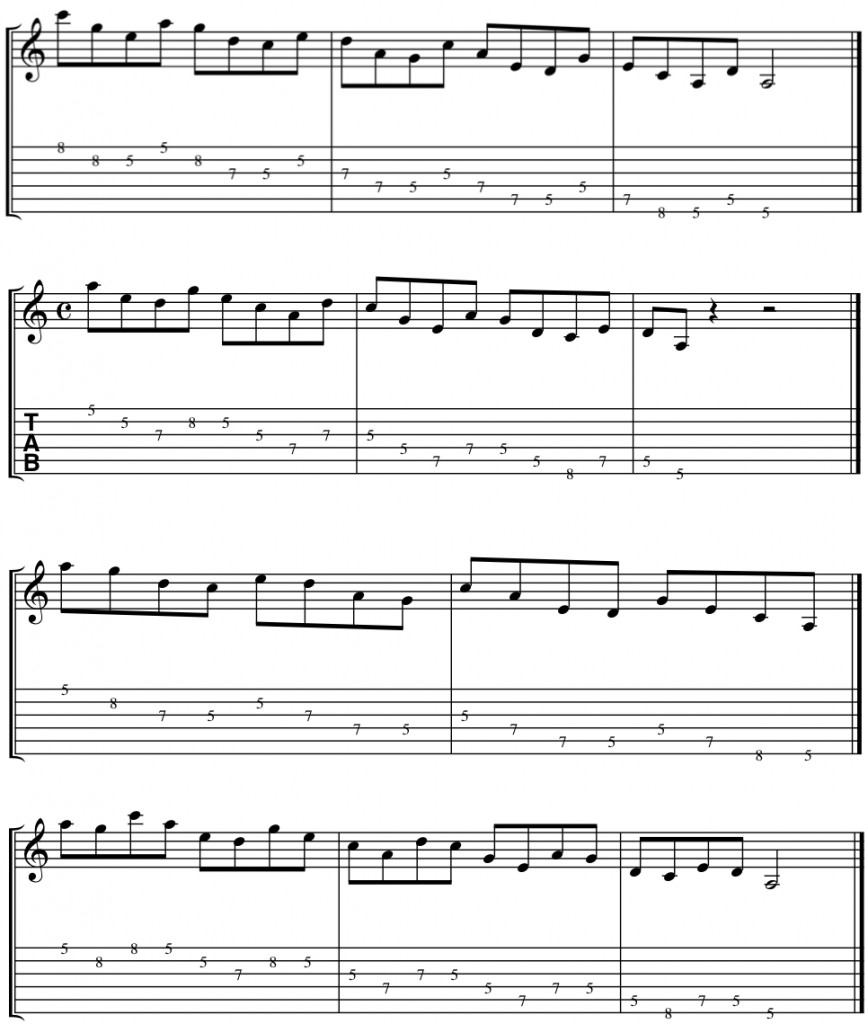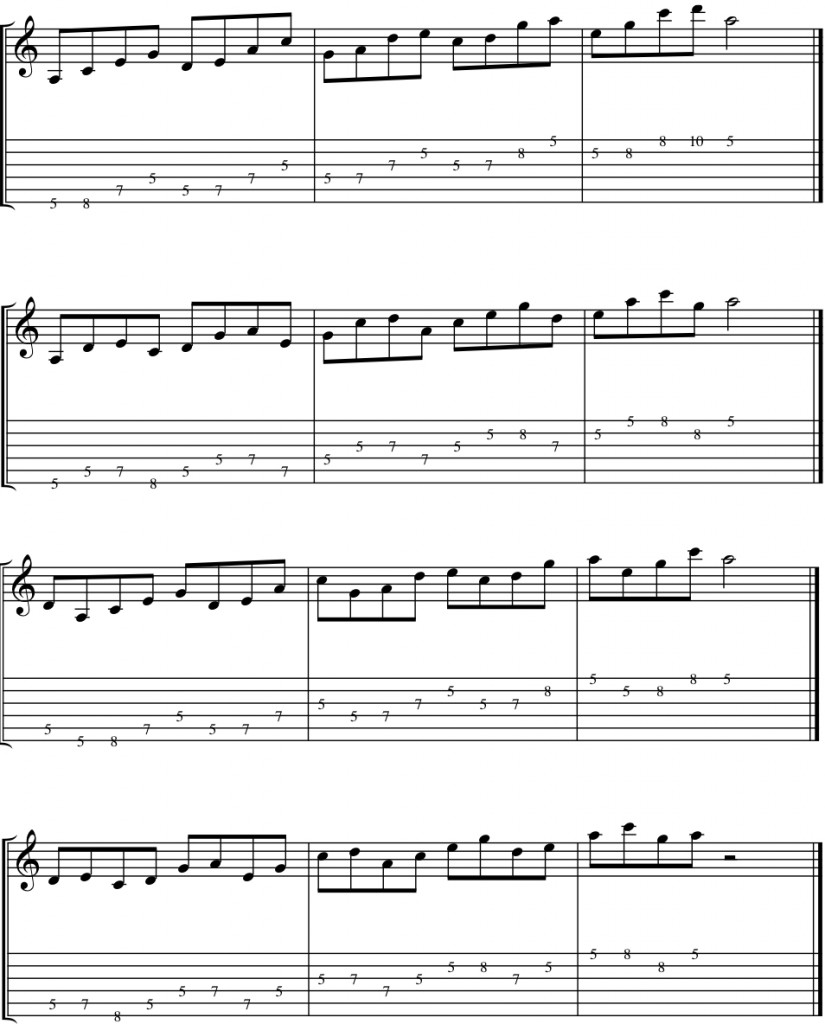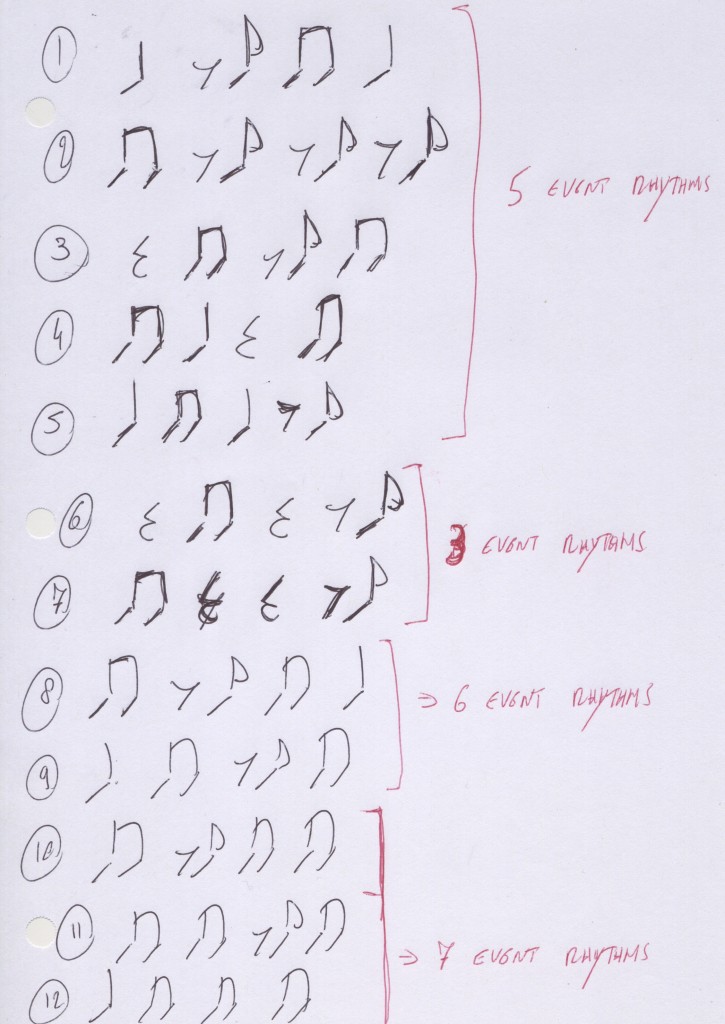Scale Patterns For Melodic Displacement Of A Scale Pattern.
This is a topic I already briefly touched upon in the series about rock improvisation techniques.
You can check that blog here for more info.
Before we get into the melodic displacement soloing technique, let me first share 8 pentatonic scale patterns you could use for this concept.
Every line is one specific pentatonic scale pattern.
You want to practice and memorize them because they are useful soloing tools.


Next week we’ll cover more cool phrases that you can melodically displace, using the technique we’re covering in this blog.
But let’s get right to the topic at hand.
Melodic Displacement Of A Scale Pattern.
When you play the above pentatonic examples, you will hear how all of these examples are 4 note sequences that move up or down the pentatonic scale.
For example, the sequence in the first A minor pentatonic scale pattern above is:
3 notes down and up 1.
You can also visually see the pattern on the sheet music. Notice how the melodic contour (the visual pattern/shape of the notes on the staff) is the same in every 4-note grouping and repeats every 4 notes.
This is called a scale pattern (also called: “a melodic sequence”.)
The melodic sequences in the examples above are really easy to hear because all the notes are played at an even subdivision of constant 8th notes.
Melodic sequences: 4 note groupings.
Rhythm: 4 evenly spaced events every 2 beats (8th notes)
So you have a melodic grouping that consists of an even number of notes, played over a rhythmic grouping that has an even number of notes/events.
But… it gets really interesting when you play 4-note sequences like the ones above, placing the notes at a rhythm that has more or less than 4 rhythmic events per bar.
For example a 5 (or 3, 6, or 7)-note/event rhythm.
Another way of explaining this:
instead of playing the notes of the 4-note melodic groupings in such a way that you have 4 or 8 notes per bar (even rhythmic groupings), which makes it really easy to hear the 4-note groupings…
what if you instead played the 4-note melodic pattern, using a 3, 5, or 6, or 7 notes rhythmic grouping. (A rhythm of 3, 5, 6, or 7 notes per bar)?
Then you have melodic displacement happening.
The 4-note melodic groupings don’t rhythmically line up anymore with the heavy (1 and 3) and weak (2 and 4) beats in the bar.
In addition: your starting note of each 4-note grouping, keeps shifting further and further with each recurring grouping.
The following example shows how this works.
The example shows how a 4-note melodic pattern shifts when played over a 5 event rhythmic grouping.

Combining the first one of the above pentatonic scale shape examples, with the rhythm of the above graphic, sounds like this:
Here are a couple more rhythms to get you started.

Conclusion
Combining any of the 8 pentatonic scale shapes with any of the 12 rhythms should keep you busy for many hours a day of practice this upcoming week.
This is a lot of stuff.
It’s also a pretty challenging soloing concept.
You might find that you have a hard time combining both the rhythm and the melodic groupings without accidentally changing the rhythm or accidentally messing up the melodic grouping.
You want to figure this out slowly.
With enough practice, it is going to click.
Once it clicks: you can literally combine any note grouping with any rhythm with any problems.
You could also have 3 note melodic groupings, with even-numbered rhythmic groupings.
The possibilities are endless.
Hit me up anytime at vreny@zotzinmusic.com if you have any questions, or if you would like to book a lesson.
These free lessons are cool, but you will never experience the progress, joy, and results that my students experience in lessons when you’re learning by yourself from blogs and videos.
That is why people take lessons: way better results and progress, much more complete information, exposed to way more creative ideas than you can get from a blog or YouTube video.
There is only so much that self-study can accomplish.
If you want to see amazing results and progress in your guitar playing, buy your first lesson here and get started ASAP.
You’ll impress your friends and loved ones in no time with your guitar playing!
Consider donating any small amount to help me keep this blog going.
Thank you for your support!


